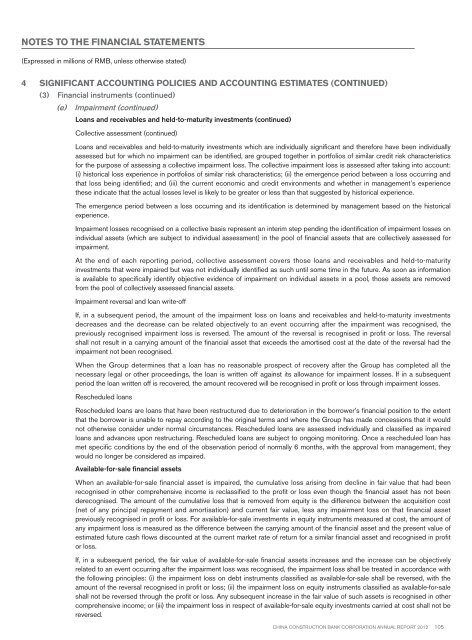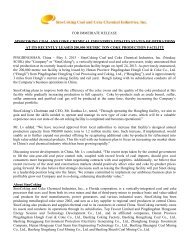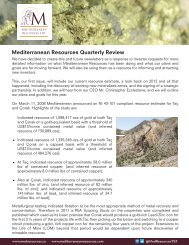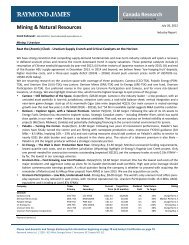Annual Report 2012
Annual Report 2012
Annual Report 2012
- No tags were found...
You also want an ePaper? Increase the reach of your titles
YUMPU automatically turns print PDFs into web optimized ePapers that Google loves.
Notes to the financial statements(Expressed in millions of RMB, unless otherwise stated)4 Significant accounting policies and accounting estimates (continued)(3) Financial instruments (continued)(e)Impairment (continued)Loans and receivables and held-to-maturity investments (continued)Collective assessment (continued)Loans and receivables and held-to-maturity investments which are individually significant and therefore have been individuallyassessed but for which no impairment can be identified, are grouped together in portfolios of similar credit risk characteristicsfor the purpose of assessing a collective impairment loss. The collective impairment loss is assessed after taking into account:(i) historical loss experience in portfolios of similar risk characteristics; (ii) the emergence period between a loss occurring andthat loss being identified; and (iii) the current economic and credit environments and whether in management’s experiencethese indicate that the actual losses level is likely to be greater or less than that suggested by historical experience.The emergence period between a loss occurring and its identification is determined by management based on the historicalexperience.Impairment losses recognised on a collective basis represent an interim step pending the identification of impairment losses onindividual assets (which are subject to individual assessment) in the pool of financial assets that are collectively assessed forimpairment.At the end of each reporting period, collective assessment covers those loans and receivables and held-to-maturityinvestments that were impaired but was not individually identified as such until some time in the future. As soon as informationis available to specifically identify objective evidence of impairment on individual assets in a pool, those assets are removedfrom the pool of collectively assessed financial assets.Impairment reversal and loan write-offIf, in a subsequent period, the amount of the impairment loss on loans and receivables and held-to-maturity investmentsdecreases and the decrease can be related objectively to an event occurring after the impairment was recognised, thepreviously recognised impairment loss is reversed. The amount of the reversal is recognised in profit or loss. The reversalshall not result in a carrying amount of the financial asset that exceeds the amortised cost at the date of the reversal had theimpairment not been recognised.When the Group determines that a loan has no reasonable prospect of recovery after the Group has completed all thenecessary legal or other proceedings, the loan is written off against its allowance for impairment losses. If in a subsequentperiod the loan written off is recovered, the amount recovered will be recognised in profit or loss through impairment losses.Rescheduled loansRescheduled loans are loans that have been restructured due to deterioration in the borrower’s financial position to the extentthat the borrower is unable to repay according to the original terms and where the Group has made concessions that it wouldnot otherwise consider under normal circumstances. Rescheduled loans are assessed individually and classified as impairedloans and advances upon restructuring. Rescheduled loans are subject to ongoing monitoring. Once a rescheduled loan hasmet specific conditions by the end of the observation period of normally 6 months, with the approval from management, theywould no longer be considered as impaired.Available-for-sale financial assetsWhen an available-for-sale financial asset is impaired, the cumulative loss arising from decline in fair value that had beenrecognised in other comprehensive income is reclassified to the profit or loss even though the financial asset has not beenderecognised. The amount of the cumulative loss that is removed from equity is the difference between the acquisition cost(net of any principal repayment and amortisation) and current fair value, less any impairment loss on that financial assetpreviously recognised in profit or loss. For available-for-sale investments in equity instruments measured at cost, the amount ofany impairment loss is measured as the difference between the carrying amount of the financial asset and the present value ofestimated future cash flows discounted at the current market rate of return for a similar financial asset and recognised in profitor loss.If, in a subsequent period, the fair value of available-for-sale financial assets increases and the increase can be objectivelyrelated to an event occurring after the impairment loss was recognised, the impairment loss shall be treated in accordance withthe following principles: (i) the impairment loss on debt instruments classified as available-for-sale shall be reversed, with theamount of the reversal recognised in profit or loss; (ii) the impairment loss on equity instruments classified as available-for-saleshall not be reversed through the profit or loss. Any subsequent increase in the fair value of such assets is recognised in othercomprehensive income; or (iii) the impairment loss in respect of available-for-sale equity investments carried at cost shall not bereversed.China Construction Bank Corporation annual report <strong>2012</strong>105
















